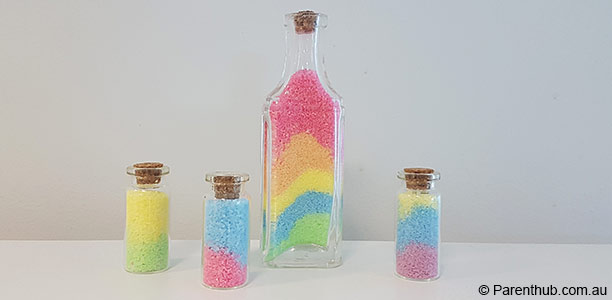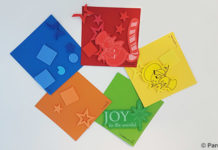Age
2-7 years
Duration of activity
This activity will keep you and your child occupied for at least an hour
Materials/equipment
- Salt
- Coloured chalk – if you have chalk in all the primary colours (red, yellow and blue), white and black, your child will be able to mix all the secondary colours (green, orange, purple, pink)
- Spoons or scoops for transferring the salt
- Snap lock bags
- Transparent jars with lids (e.g. old vegemite or peanut butter jars)
Cost
The materials you need for this activity will cost just a few dollars. Don’t forget to recycle – it’s a great chance to get rid of pieces of chalk that are too small to write with, and old food jars.
Preparation
Collect all the equipment your child will use to make the fairy dust jars and find a space for them to work.
What to do
Making the ‘fairy dust’
 Explain to your child that today you are going to make coloured fairy dust, and learn about mixing colours as you go.
Explain to your child that today you are going to make coloured fairy dust, and learn about mixing colours as you go.- Before you begin mixing, spend a few minutes talking with your child about mixing colours, and how when two colours are mixed together they make a new colour. If they are already learning about mixing colours, ask them to name different combinations of colours (e.g. red and blue) and the new colour they will get if they mix them together (e.g. purple). If not, tell them that red, blue and yellow can be mixed together to make other colours, and today they’ll mix these colours together to make new colours, like green and orange. Also explain that they can add white to any colour chalk to make it lighter, and black chalk to any other colour to make it darker. For example, adding white chalk to blue will make light blue and adding black to blue will make dark blue.
- Give your child a snap lock bag and ask them to pour about a cup of salt into it. You might get them to pour the salt straight out of the bag you bought it in, or you could first pour it into a container with a wide opening, and ask them to use a spoon or scoop to transfer it into the bag. Your child will probably enjoy the process of spooning the salt into the bag.
- Next ask your child what colour they would like to make their first batch of fairy dust.
- Ask them if they see the colour they want amongst the chalk – if they do, it is a primary colour. Talk about primary colours, for example that they are colours that cannot be made by mixing two other colours together, but can be mixed together to create new colours. If they don’t see the colour they want amongst the chalk, it’s a secondary colour. Ask your child what colours they think they need to mix together to make the colour they want. Don’t worry if they don’t get the answer right, they’ll have an opportunity to mix the colours and see the result for themselves.
 Ask your child to add the colour/s they have selected to the salt in the snap lock bag.
Ask your child to add the colour/s they have selected to the salt in the snap lock bag.- Ask them to seal the snap lock on the bag. Once they have tried to seal the bag, check that it is properly closed and seal any parts they have missed so that the salt doesn’t spill.
- Once the bag is properly sealed, ask your child to rub the salt and chalk together in the bag. They can do this by placing the bag on a table or flat surface and rolling it back and forward, or holding the bag between their palms and rubbing.
- As they rub, the salt will absorb the colour from the chalk. Encourage them to stop rubbing and observe the results at different stages (after they have just rubbed the bag a few times, after they have counted to ten or twenty and so on). Ask them what colour the salt is becoming. If they have mixed together two different chalk colours, they might first see different sections of the salt becoming these two separate colours. If they keep rubbing they will notice the two colours start to mix together to form a new colour. Ask them if the resulting colour is what they expected. Ask them what they think of the colour, for example if they like it or what it reminds them of. Tell them what you think of the colour.
- Encourage your child to keep rubbing the salt bag until all the salt has absorbed colour from the chalk and the colour is reasonably consistent.
- Place the bag aside.
- Repeat until you have several different salt colours that can be used to make pretty layered jars of fairy dust. You will need at least two colours, but you can mix as many as your child wants to.
Making the fairy dust jars
- Give your child a jar and tell them they will use it is make a layered pattern with the coloured fairy dust they have made. Explain to them that they will do this by adding layers of the fairy dust, one colour at a time, until the jar is full. Emphasise that it is important that they do not shake the jar while they are making the layers, or the colours will all mix together, instead of making separate layers.
- Ask your child to take the fairy dust colour they want to use to make the first layer.
- Instruct your child to pour, spoon or scoop a small amount of the coloured salt into the bottom of the jar. Remind them that when the jar is finished, they will only be able to see the salt that meets the edge of the jar, so they should try and pour or scoop the salt so that it touches the edges.
 Ask your child to select another colour, and pour or scoop it to create a second layer in the jar. Remind them to make sure the layer goes all the way to the edge of the jar, so that it will be seen when the jar is complete.
Ask your child to select another colour, and pour or scoop it to create a second layer in the jar. Remind them to make sure the layer goes all the way to the edge of the jar, so that it will be seen when the jar is complete.- Ask your child to keep adding layers until the jar is full.
- As your child adds layers, encourage them to talk about the pattern they are making. They might describe the pattern of the colours, for example repeating red then orange then yellow layers. Or they might describe the size or shape of the layers, saying for example that there are thick and then thin layers, ordered in some way.
- When the jar is full to the brim ask your child to put the lid on, taking care not to shake the jar and mix up the colours. Help them out if they struggle.
- Count the number of layers in the jar. Look at the jar from different angles to see if the number of layers is always the same, or if some sides of the jar have more layers than others.
- Place the jar on display in a place your child can see it easily. You can keep talking about the colours and patterns.
Tips
- Using different implements (e.g. spoons and scoops) to transfer the salt will give your child the opportunity to use their hands in different ways and develop different muscles in their hands and fingers.
Safety
- Use plastic jars which will not break if they are dropped.
- Supervise your child at all times while they are doing this activity and ensure they never cover their mouth and/or nostrils with a plastic snap lock bag.
- Coloured fairy dust looks pretty good and some children might try to eat it. Advise your children not to eat the coloured salt and keep an eye on them to make sure they don’t.
Educational outcomes
Mathematical skills
Colour
This activity will help your child learn to recognise and name colours as well as to understand the relationship between primary and secondary colours and how colours change when they are mixed together. They’ll also be developing their problem solving skills, when they attempt to mix two colours together, to get a desired result. Encourage them to use colour names and words to describe the colours (e.g. dull, bright). These words are an important part of their mathematical vocabulary, and practicing using colour words is one of the best ways to help young children master them.
Vocabulary
Your child will also develop their mathematical vocabulary by using words to describe the size of salt layers and their location in the jar. These include words like thick and thin (or big and small for younger children) and top, bottom and middle.
Pattern
As your child makes layers of salt in the jar they are making a pattern. Asking them to describe the pattern, in terms of colour, size or shape, is a great way to develop their understanding of what patterns are and how they are made. They’ll learn by making their own original patterns and describing their features, as well as by copying patterns. For example you could ask them to copy the pattern in a salt jar you made earlier, or draw a pattern on paper and ask them to make the pattern in their salt jar.
Counting
If you encourage your child to count as they do this activity, you’ll be providing an opportunity for them to develop another important mathematical skill. You might want to count as they rub the salt and chalk together, for example count to ten or twenty before stopping to observe what’s happening. You might also want to help them develop counting skills by counting the number of layers in the jar when they have finished or how many different colours they have made. Encourage them to point as they count, to help them understand one to one correspondence, that is, that each number counted represents one thing.
Fine motor skills
This activity provides excellent opportunities for your child to develop their fine motor skills, that is, their ability to use their hands and fingers to manipulate objects. They’ll be using different groups of finger muscles to pour or scoop salt between bags and jars, to rub and roll the salt to mix it with the chalk, to close snap locks or put lids on jars. At the same time they’ll be strengthening their finger muscles and developing their ability to control their finger movements.
Persistence, curiosity and creativity
As your child experiments with mixing different colour combinations to make new colours, and making colour patterns with their fairy dust, they’ll be using and expanding their creativity. Listen out for comments like, “I wonder what will happen if…”. These types of comments show your child is curious. Encourage them to explore whatever it is they’re curious about.
Encourage your child to experiment and try not to intervene – they’ll learn more if they mix two colours and get a result they didn’t want, than if you intervene to tell them the right answer. If at first they don’t get the result they want or expect, encourage them to keep trying. This helps them develop persistence and problem solving skills. For example if they have already mixed yellow and red and red and blue and still haven’t made colour green, they can solve the problem by mixing blue and yellow (the two primary colours they haven’t yet tried). If they remember the colours they have already mixed, it’s a great sign that their concentration skills are developing. If they don’t, help them out by making suggestions that will help (e.g. why not try mixing blue and yellow now) instead of telling them the answer. Encourage them to keep trying by complimenting them for persisting.
Communication and social skills
Young children are social beings, and every time they socialise (including when they socialise with you while making fairy dust), they be developing their social and communication skills. These include things like listening, being able to form questions and answers, and communicating in respectful ways (e.g. not talking over the top of someone else and answering if they are asked a question). It’s important for adults to model respectful communication, for example to listen to children when they speak and answer when they ask a question.
References
- Virginia Early Childhood Development Alignment Program. Milestones of child development- A guide to young children’s learning and development from birth to kindergarten. 2013. (cited 12 March 2017). Available from: (URL Link)
- Jeppson J, Myers-Walls JA. Children and Colours. Purdue University- Human Development Extension. 2003. (cited 12 March 2017). Available from: (URL Link)
- Smith College. Colour mixing. 2013 (cited 12 March 2017). Available from: (URL Link)



 (4 votes, average: 4.00 out of 5)
(4 votes, average: 4.00 out of 5) 






